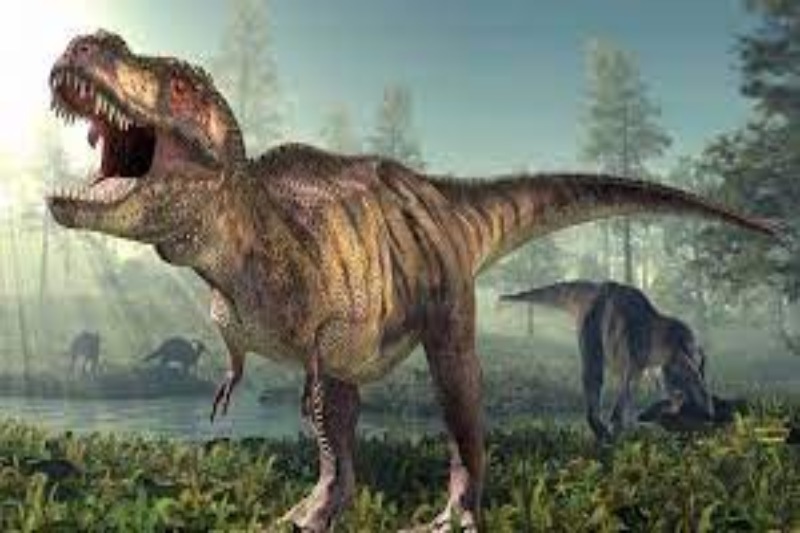A study released on Thursday identifies a new related of the most famous dinosaur ever, the Tyrannosaurus rex, that was previously unidentified. The discovery offers a fresh piece of information that may enable paleontologists to piece together an earlier stage of the evolutionary process that culminated in the giant predatory tyrannosaur T. rex.
Known as Tyrannosaurus mcraeensis, it probably roamed the planet for up to 7 million years prior to the emergence of Tyrannosaurus rex. According to dating estimates, the bones belong to the late Campanian–early Maastrichtian Period and are 72–73 million years old.
However, decades before Tyrannosaurus mcraeensis was given its formal scientific name, its bones were found. Throughout the course of the 1980s and early 1990s, in what is now known as Elephant Butte, New Mexico, around 25% of its fossilized skull was discovered. The New Mexico Museum of Natural History & Science initially classified the bones as belonging to the Tyrannosaurus rex, a species that could reach lengths of up to 12 meters and weights of 10 tons, due to the size of the fossils.
T. rex and its kin
Between T. rex and T. mcraeensis, there were two key distinctions.
“The lower jaw in a Tyrannosaurus rex is actually quite robust. Our jaw is obviously big and toothy, but it’s more slender than what we normally see in a Tyrannosaurus rex,” said Anthony R. Fiorillo, coauthor of the study published Thursday in the journal Scientific Reports. The robust jaw of T. rex meant it “could do whatever it wanted. A more slender jaw, even with the big teeth, means that it would have less bite force.”
Another notable distinction was that T. mcraeensis lacked the noticeable ridge covering its eyes, which was present in T. rex. As with antlers on deer or elk, scientists think that T. rex’s ridge served as a means of attracting mates, according to Fiorillo, executive director of the New Mexico Museum of Natural History & Science in Albuquerque. The ridge of T. mcraeensis is considerably more delicate.
Why not go big?
Massive tyrannosaurs presumably arose as an evolutionary adaption to the availability of large herbivores, the authors wrote. The study notes that the precise reason why enormous plant-eating dinosaurs emerged is still a mystery.
Fiorillo highlighted that he added that T. mcraeensis most likely did not face significant changes in temperature and light in southern North America, which allowed it to continue growing, in contrast to the pygmy tyrannosaur discovered in the Arctic, known as Nanuqsaurus hoglundi. Although N. hoglundi’s noticeably tiny size may have been influenced by arctic environments, other tyrannosaurids from the same epoch were typically much smaller than T. mcraeensis.
In order to look for more bones, the study team will now go back to the rock formation where the specimen was discovered.
“Then, because it’s so big, we need to actually shift some of our investigation to try to understand the paleoecology and environment in which this animal lived so we can begin to understand what was it about New Mexico that was so special that this animal’s adaptation to life was to get big,” Fiorillo said.
A dinosaur detective
There weren’t many T. rex specimens available when the lower jaw was originally discovered, according to Fiorillo.
Sebastian G. Dalman, the study’s original author and an associate researcher at the museum as well as a paleontological consultant with the Springfield Science Museum in Massachusetts, made the identity of T. mcraeensis known all these decades later.
While researching the bones starting in 2013, Dalman was the first person to indicate that they “might be something different,” Fiorillo said.
Since T. rex was the biggest apex predator of its era, professional and amateur paleontologists have been studying it almost nonstop for decades. According to Fiorillo, the fierce giant’s fascination and his large parts in popular blockbusters like “King Kong” and “Jurassic Park” have increased interest in T. rex bones among experts and amateur fossil hunters alike.
“And that improved our sample size,” he said. “That set the table for when Sebastian started to look at our specimen and say, ‘Hey, these don’t actually look the same as the famous Tyrannosaurus rex specimens from places like Montana.’”





